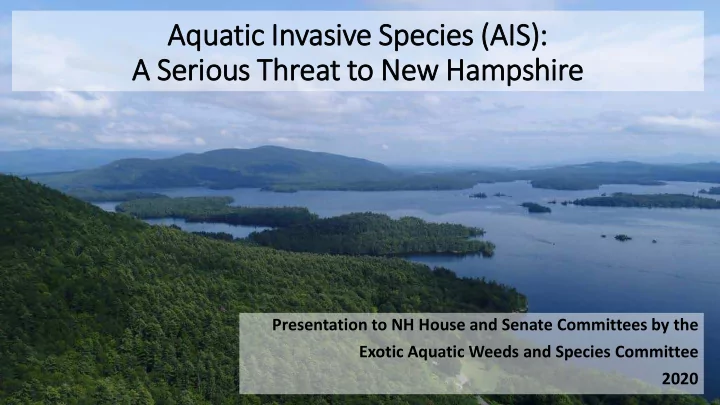

Aquatic c Invasi sive S e Speci ecies ( es (AIS): ): A S Serious Threa eat to N New ew H Hamp mpshire Presentation to NH House and Senate Committees by the Exotic Aquatic Weeds and Species Committee 2020
Agenda 1. The nature and scope of the aquatic invasive species threat 2. Ongoing actions to prevent and mitigate the risks 3. Future outlook – are we doing enough?
Definition of Invasive Species An invasive species is defined as a species that is: 1. Non-native (or alien) to the ecosystem under consideration and, 2. Whose introduction causes or is likely to cause economic or environmental harm or harm to human health.
Known AIS-Infested Waterbodies in New Hampshire
Most Threatening AIS to New Hampshire Variable Milfoil in Squam Lake – Asquam Cove
Most Threatening AIS to New Hampshire Fanwort – Robinson Pond, Hudson
Most Threatening AIS to New Hampshire Water Chestnut – Nashua River
Most Threatening AIS to New Hampshire European/Brittle Naiad – Present in 6 NH waterbodies.
Most Threatening AIS to New Hampshire Asian Clams – Merrimack River (Bow)
Economic Sectors Impacted Recreation, tourism and boating
Economic Impact – What’s our Water Worth? • Property taxes • Infestations can reduce property values by 10-20% • In Meredith, NH, only 25% of properties are on the waterfront. Waterfront properties make up over 50% of the town’s total assessed property value. • Tourism • ~$5 billion a year
Economic Impact – What’s our Water Worth? • Recreational fishing • ~$215 million per year • Visitors to freshwater state parks • ~$40 million per year • Out of state, transient boaters • ~$100 million per boating season
Potential Future Economic Sector Impacts Dam Intake Tower Marine Tripod Clogged Water Pipe Agricultural Irrigation System Power Plant Water Intake Water Treatment Plant Aquatic invasive species are moving east. These photos were taken in the Great Lakes area.
New Hampshire’s AIS Threat Mitigation Process
Prevention and Early Detection (need River Runners photo) Legislation Lake Hosts, Weed Watchers, River Runners, Outreach
Best Available Technologies to Prevent AIS
Rapid Response, Treatment & Control Treatment & Control Rapid Response DES Divers & DASH Unit Hand-Pulling by Certified Diver Diver Assisted Suction Harvest (DASH) Unit Benthic Barrier Herbicide Application
Long-term Management 5-Year, long-term management plans: • Developed for 65 NH waterbodies • Integrate management techniques • Utilize public-private partnerships
State Agencies NHDES Exotic Species Program • Responsible for aquatic invasive plant species • One full-time employee • One seasonal intern • Funded from boat registration fees, general fund and AIS decal
State Agencies Department of Agriculture, Division of Pesticide Control • Manages applications for herbicide treatments • One partial full-time equivalent
State Agencies New Hampshire Fish and Game Department • Responsible for aquatic invasive animal species (clams, mussels, insects, etc.) • No dedicated staff or funding • No monitoring or rapid response plan
Exotic Aquatic Weeds and Species Committee • Established in 2004 by RSA 487:30 • Members include legislators, state agencies, non-profit organizations, and public members • Responsible for: • Studying the spread and control of AIS • Studying best management practices used in other states • Assisting NHDES • Recommending a program to NH Fish and Game for aquatic invasive animals
Funding for AIS Activities NH DES Exotic Species Program funding comes primarily from dedicated boat registration fees. This funding covers prevention and control grants, research, salaries, administration, and supplies & materials. 1981: $0.50 per boat registration 1998: $1.50 per boat registration Annual average of 92,500 boats 2003: $4.50 per boat registration registered during past 5 years 2009: $7.50 per boat registration 2015: $9.50 per boat registration
Funding for AIS Activities Other sources of funding include: • General funds – new as of 2020 • ~$400,000 over the biennium • Decals – new as of 2020 • ~$150,000 per calendar year • Private donations • Municipal funds
Fund Funding for AIS Activiti ties • Ossipee Lake Alliance study • Variable milfoil is, by far, the most prolific AIS in NH, infesting 74 waterbodies • More than $1 million is spent each year on milfoil control projects • Surveyed annual costs and revenue sources for milfoil control projects in all infested waterbodies in 2009-2012 • All “State” revenues come from dedicated boat registration fees – none from general funds
The The Thr Threat t is Serious and nd Will I Inc ncrease • AIS are currently causing significant economic and environmental impacts. • The threats and impacts will continue to grow. • Uncontrolled AIS could devastate NH tourism revenues. • Currently, most AIS activities are paid for by boaters, municipal governments, and donations from businesses and private citizens.
Funding We Need Cooperative Your Outreach partnerships Support Implementing new techniques
Wha hat W t We CAN N Accomplish Asquam Cove, Squam Lake – before and after milfoil management
2019 2019-2020 EAWSC M Membe bershi hip • Rep. Suzanne Smith • Kelly Buchanan (NH LAKES) • Rep. Jane Beaulieu • June Fichter (public member) • Rep. Karen Ebel • Robert Reynolds (public member) • Rep. John Klose • Will Stevenson (New England Aquatic Plant Management Society) • Rep. Rosemary Rung • Michele Tremblay (New Hampshire Rivers • Sen. Melanie Levesque Council • Glenn Normandeau (NH Fish & Game) • Kathy Urffer (Connecticut River Watershed • Amy Smagula (NH DES) Council) • Matthew Bosiak (NHDAMF Pesticide • Vacant (NH Marine Trades Assoc.) Control) http://www.gencourt.state.nh.us/statstudcomm/committees/587/
Recommend
More recommend